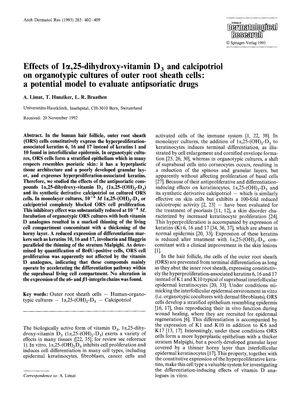TLDR Vitamin D compounds may help treat psoriasis by promoting skin cell differentiation.
In the 1993 study, the effects of 1α,25-dihydroxy-vitamin D3 and calcipotriol on outer root sheath (ORS) cells were examined to assess their potential as antipsoriatic drugs. The study demonstrated that at a concentration of 10^-6 M, both compounds completely halted ORS cell proliferation in monolayer cultures, but had a reduced effect at 10^-8 M. In organotypic cultures, the compounds led to a thinner living cell layer and a thicker horny layer, with decreased expression of differentiation markers, without affecting cell proliferation. This suggests that the vitamin D analogues primarily promote differentiation rather than inhibit proliferation, which could be advantageous in treating psoriasis. However, the number of individuals from whom ORS cells were derived was not mentioned.
31 citations
,
December 1991 in “Annals of the New York Academy of Sciences” ORS and hair matrix cells balance growth and differentiation better than normal keratinocytes, with human dermal fibroblasts crucial for proper differentiation.
135 citations
,
November 1987 in “Differentiation” Outer root sheath cells consistently express certain keratins influenced by their environment.
277 citations
,
October 1982 in “The Journal of Cell Biology” Basal-cell epitheliomas and the pilosebaceous tract share a unique keratin, distinguishing them from other skin areas.
 1308 citations
,
March 1998 in “Journal of bone and mineral research”
1308 citations
,
March 1998 in “Journal of bone and mineral research” The vitamin D receptor is crucial for bone health and affects various body systems, with mutations potentially leading to disease.
 2 citations
,
November 2017 in “PloS one”
2 citations
,
November 2017 in “PloS one” Some vitamin D analogs can thicken skin and reduce pore size like a common acne treatment, with one analog also affecting skin growth factors.
 1533 citations
,
October 2008 in “Endocrine reviews”
1533 citations
,
October 2008 in “Endocrine reviews” Mice without the vitamin D receptor have bone issues and other health problems, suggesting vitamin D is important for preventing various diseases in humans.
15 citations
,
March 2000 in “The journal of investigative dermatology/Journal of investigative dermatology” As skin cells mature, vitamin D receptor levels decrease while retinoid X receptor α levels increase.
 May 2025 in “Journal of the Egyptian Womenʼs Dermatologic Society”
May 2025 in “Journal of the Egyptian Womenʼs Dermatologic Society” Vitamin D3 is a safe and effective alternative to steroids for treating alopecia areata, with fewer side effects.





